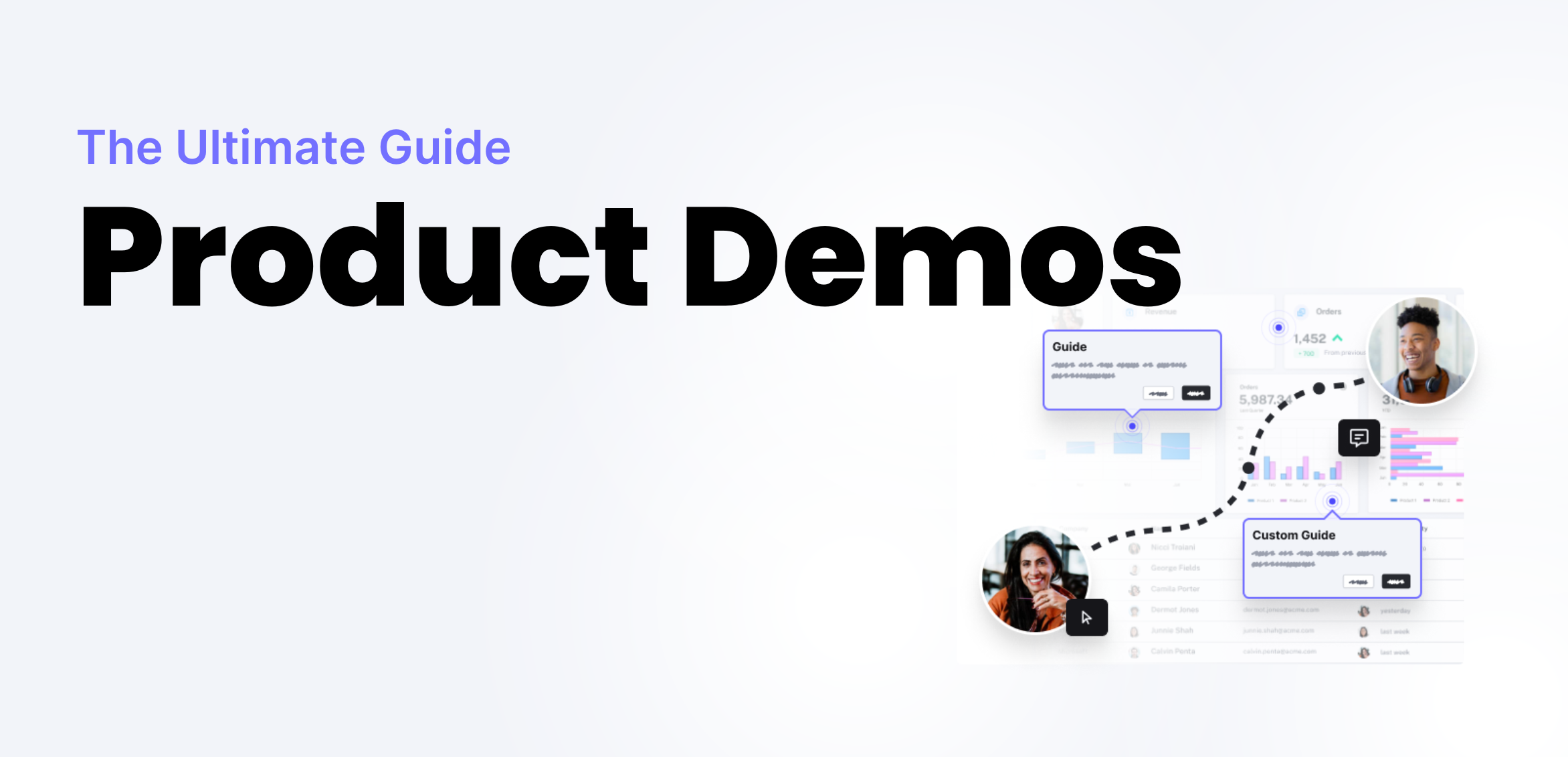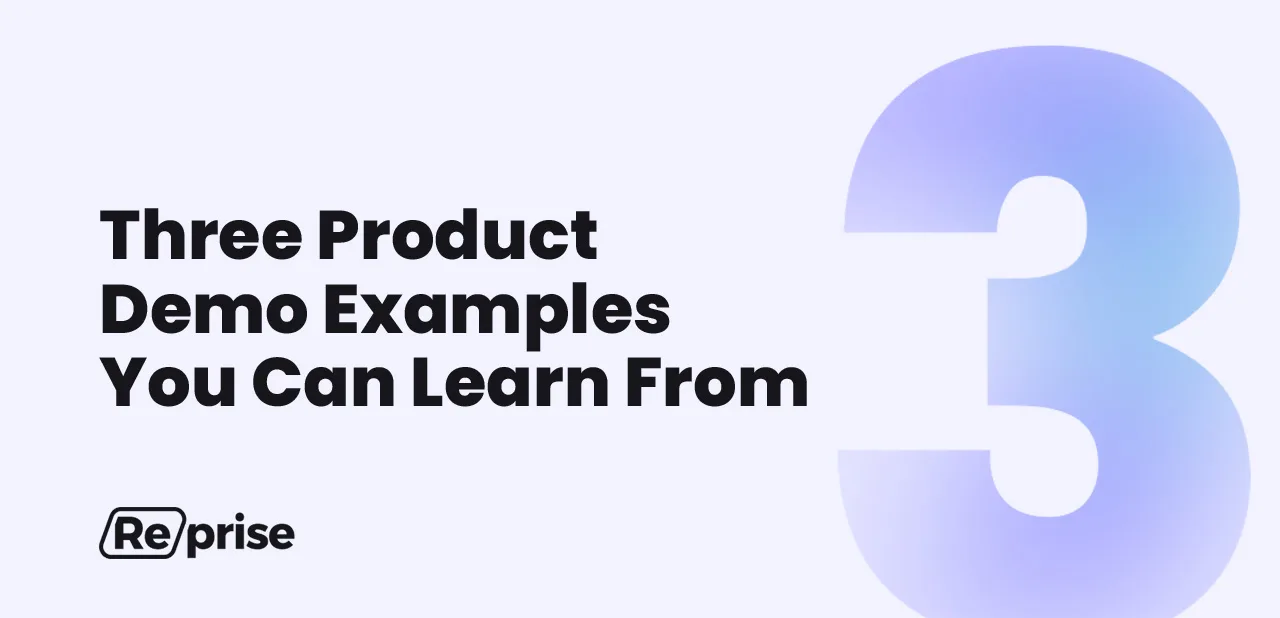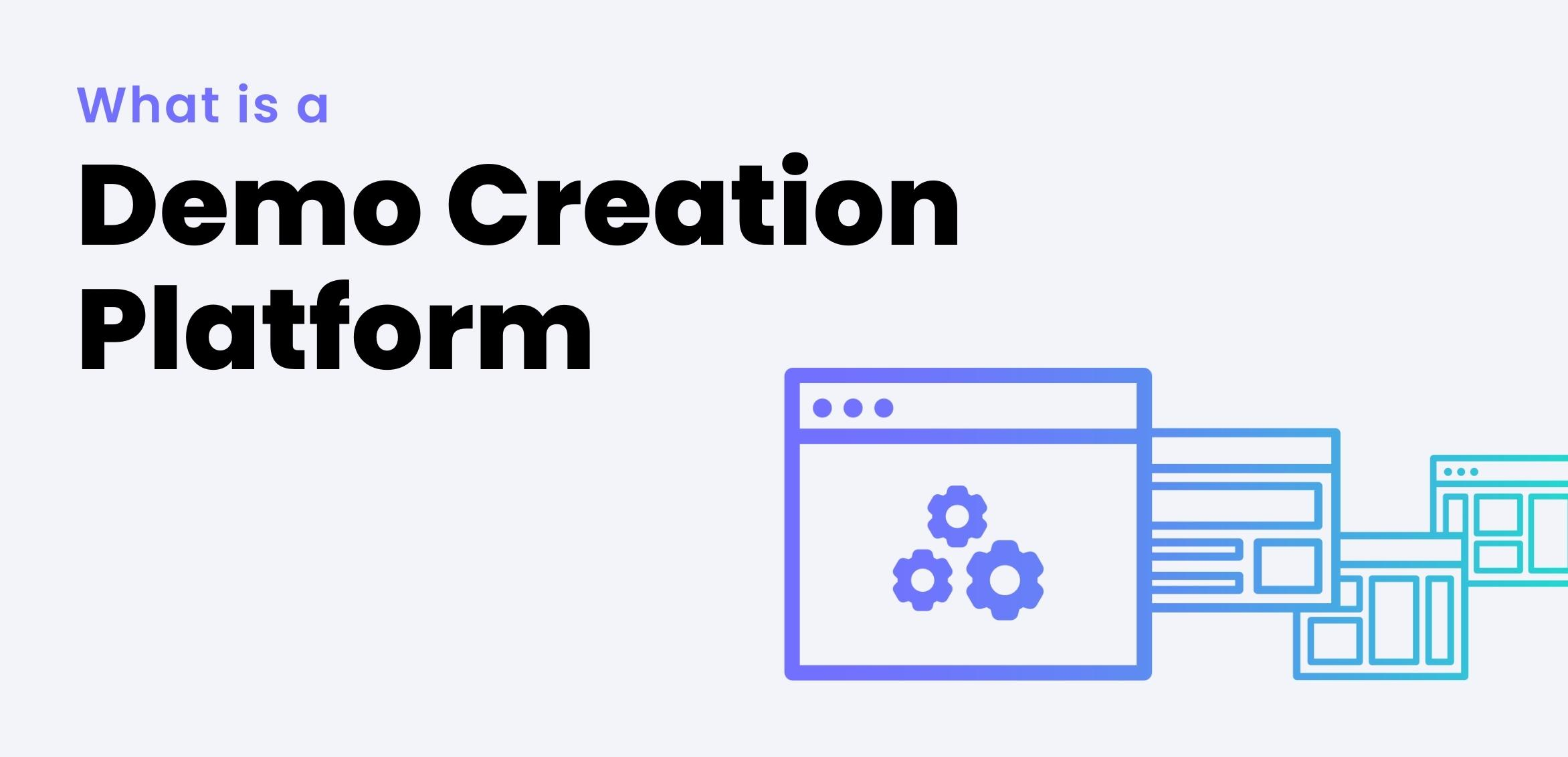The Ultimate Guide to Product Demos

In modern enterprise sales, sales reps only get about 5% of a customer’s time. Before speaking with a rep, most buyers look to self-educate on a vendor’s website. Even after a sales conversation, prospects may carefully weigh the purchase decision with peers via a buying committee. Regardless of the stage in the buyer journey, product demos can shorten sales cycles and increase conversions. A product demo, or product demonstration, showcases a product’s features, benefits, and functionality in action. In this guide, we dive deep into the world of product demos, exploring their benefits, types, and their pivotal role in navigating the complex modern sales cycle.
You can read this guide from start to finish or skip to the sections you’re most interested in learning about.
The sales funnel for product demos
The best product demo creation tool
Frequently asked questions: demystifying product demos
What is a product demo?
A product demo is a presentation or interactive showcase of a product’s features, benefits, and functionalities. It is a strategic and visual way for businesses to effectively communicate the value of their products to potential customers. Product demos provide a tangible and experiential understanding of how a product works and how it can address the needs and pain points of the target audience.
In a product demo, businesses typically highlight the key aspects of their product through various means such as live presentations, interactive demos, video presentations, or even hands-on experiences. The aim is to engage the audience, create a memorable experience, and convey the unique selling points that differentiate the product from competitors.
By showcasing a product in action, a product demo goes beyond text-based descriptions and abstract explanations, giving potential customers a concrete understanding of how the product can meet their requirements. This approach helps build trust, establish credibility, and address any uncertainties that potential customers may have about the product’s capabilities.
Overall, a product demo serves as a powerful tool in a company’s go-to-market arsenal, playing a crucial role in influencing purchasing decisions and driving conversions.
Benefits of product demos
Product demos elevate sales processes to new heights of efficiency and effectiveness. By providing tangible evidence of a product’s capabilities, they transcend mere descriptions and provide evidence of how a product will work for potential customers. Sales team members can rely on direct feedback gained through the discovery process to tailor product demos to meet the needs of their prospect.
Demos give customers a taste of product ownership before they commit to making a purchase. For marketing teams, these demonstrations can elevate a company brand, creating a great first impression and instilling confidence in a product’s fit for a prospect. Ultimately, a high-quality product demo can be the driving force behind closed deals.
Product demos hold significant importance for businesses across industries, serving as invaluable tools that can make a substantial impact on various aspects of their operations and success. Here’s a closer look at why product demos are important:
Clear Communication of Value
A product demo allows you to visually and experientially communicate the value of your product to potential customers. Instead of relying solely on textual descriptions or static images, a demo brings the product to life, showing exactly how it works and how it can benefit the customer. This clear and tangible presentation of value helps potential buyers better understand how your product can meet their needs.
Addressing Customer Pain Points
Product demos provide a platform to address specific pain points and challenges that potential customers may have. By showcasing how your product can solve real-world problems, you demonstrate that you understand a prospect’s needs and are offering a viable solution. This personalized approach enhances the relevance of your product and increases the likelihood of conversion.
Building Trust and Credibility
Demonstrating your product’s capabilities in a real-time setting builds trust and credibility. Potential customers can see the product in action, which helps establish authenticity and minimizes skepticism. When they experience the product’s benefits firsthand, they are more likely to believe in its claims and view your business as a reliable source.
Engagement and Company Brand Building
Product demos are engaging by nature. They captivate the audience’s attention, keeping them focused on your product and its features. This engagement leads to better retention of information and a stronger connection with your brand. An engaging demo experience can leave a lasting impression, making your product more memorable.
Faster Decision-Making
Seeing a product in action can expedite the decision-making process for potential customers. A well-executed demo provides stakeholders with the necessary information to evaluate the product’s fit for their needs. However, you don’t have to have every decision-maker in the room for every demo. Interactive demos can enable companies to build consensus in the buying process, without requiring repetitive demos to multiple stakeholders. This can reduce the time spent on research and consideration, leading to quicker purchasing decisions.
Direct Feedback Loop
Product demos enable you to receive direct feedback from potential customers. As they interact with the product, they may ask questions, share concerns, or provide insights. This feedback is invaluable for improving your product, enhancing its features, and refining your marketing and sales strategies.
Differentiation from Competitors
In a competitive market, standing out is crucial. A compelling product demo allows you to showcase what makes your product unique and superior to competitors. It’s an opportunity to highlight key differentiators and position your product as the optimal choice.
Enhanced Sales Processes
Product demos streamline the sales process by providing a tangible and persuasive presentation. They serve as a powerful tool for sales representatives to guide potential customers through the buying journey. Well-prepared demos can help overcome objections, address doubts, and ultimately close deals more effectively.
In essence, product demos play a pivotal role in bridging the gap between a potential customer’s curiosity and their decision to purchase. They facilitate understanding, build trust, and provide a memorable experience that can set the stage for long-term customer relationships and business success.
Types of product demos
Businesses rely on different types of product demos to engage audiences and showcase their offerings in the most compelling way. Each type caters to diverse preferences and varying stages of the customer journey. From interactive product demos to product tours to personalized demos, let’s explore each of the product demo variations.
Interactive Product Demos
Forrester research shows that 60% of buyers will go to a vendor’s website before accepting an online or in-person sales meeting. Interactive product demos are a great first step for buyers to explore a product’s key features and benefits hands-on. Unlike static product tours, interactive demos empower potential customers to explore a product in a meaningful way. They serve as immersive experiences that drive sign-ups and ensure customers are well-acquainted with SaaS tools’ functionalities. Many companies choose to add interactive product demos to their homepage or marketing campaigns to engage prospects looking to self-evaluate.
Product Tours
Self-guided product tours offer a customer-driven way to explore features. This allows users to learn about the product at their own pace, diving deeper into the functionality that matters most to their specific pain points. Ultimately, many teams choose to embed product tours via an interactive demonstration on their product page, driving user satisfaction in the evaluation process.
Personalized Demos
Once prospects are ready to talk to sales, live demos can play a critical role in closing the deal. According to a study from Bain & Co. demos are one of buyers’ most widely used sources of information during the consideration stage: 72% of respondents said the vendors they ultimately chose outperform the rest of the field by using demos and trials. By addressing the specific pain points and challenges of prospects, personalized demos bring customization to the sales process. These demos typically follow a qualifying marketing interaction or discovery call. Live demos enable teams to achieve personalization in sales, by helping prospects visualize how a product will work for their needs, or within their specific environment.
Video Demo Tools & Videos
While video demos hold potential, they come with downsides such as limited interactivity and personalization. However, when used strategically, they can provide quick insights into a product’s features and benefits. Popular video demo tools enable businesses to create compelling product demo videos that capture attention and convey value effectively. While product demo video examples abound on enterprise companies’ websites, interactive demos may get twice as much engagement as static content — such as the product screenshots typically shared within a demo video.
The Sales Funnel for Product Demos
Companies can use product demos throughout the enterprise buying cycle. In the awareness phase, marketers and product teams embed interactive demos on the website to help buyers understand product value immediately. According to Forrester, interactive product tours featured on the website resulted in 60% uplift in average website interactions that converted to leads.
From there, sales and presales teams use live, personalized demos to tailor the product experience to a prospect’s specific use case or pain points. In the closing phases, interactive product tours can help buying committees evaluate products, even in the absence of final sales interaction.
Here are a few ways different personas can use product demos throughout the sales funnel.
Prospective Customers
The product demo process serves as a prime opportunity to delight prospective customers. Early in the buyer experience, interactive demos can help prospects self-evaluate. Further down in the sales funnel, personalized demos can help in building relationships and fostering trust among buyers. Live demos should be a two-way conversation rather than a rehearsed presentation — successful reps look at demos as an opportunity to engage buyers about their pain points and highlight product features most relevant to their needs.
Sales Reps & Marketing Professionals
Both sales representatives and marketing professionals can leverage demos as a tool for showcasing a product, building trust, and improving the buyer experience. Through effective product demonstrations, they can forge connections with prospective customers and lay the foundation for long-term relationships.
Delivering successful sales presentations and demonstrations requires careful planning, effective communication, and a deep understanding of the audience’s needs. To do it right, honing in on your target audience’s industry, challenges, and pain points is critical to tailoring your presentation to address specific needs and concerns. Customize examples and scenarios that resonate with your audience’s experiences. Know your product inside and out, and be prepared to handle potential objections or questions that may arise during the live demo process.
Sales Cycle & Process
The product demo weaves seamlessly into the sales cycle, catering to each stage of the buyer’s journey. From the awareness stage to the consideration stage and beyond, product demos accelerate the buyer’s journey, facilitating more informed decisions. Both interactive and personalized demos play a pivotal role in shortening the sales cycle, making them an indispensable asset.
Here are a few ways to use demos throughout the sales cycle:
- Awareness stage: Interactive demos can be used directly on the website or product page, or embedded within marketing materials to showcase product benefits directly.
- Consideration stage: Live demos help sales teams connect directly with buyers based on their individual needs, and are often a critical part of the sales process.
- Decision stage: According to our recent survey of sales practitioners, the majority of enterprise sales teams (86%) have lost a deal to a committee decision at least once in the last month. Instead of the typical PDF or demo video recording, an interactive demo can guide buying committees through the best features within your solution, making it much easier for your champion to help you close the deal.
Sales Presentations & Demonstrations
Sales presentations and demonstrations serve as the dynamic duo that brings a product to life. Through strategic planning, engaging content, and personalized delivery, sales presentations and demonstrations bridge the gap between a product’s potential and the customer’s understanding, laying the foundation for successful conversions.
Delivering a successful sales presentation requires careful research of a buyer’s industry, pain points, and objectives. From there, it’s key to develop a narrative that highlights relatable scenarios or customer case studies. Showcase what sets your product apart from competitors, by comparing your product’s features and benefits to alternatives in the market. The ultimate goal is to clearly articulate the value that the product offers to the prospective customer.
The Best Product Demo Creation Tool
The right demo creation platform should help anyone on your go-to-market team build demos quickly and easily. Demo creation platforms make it possible for go-to-market teams to generate and share high-fidelity, custom interactive demos that look, feel, and behave just like a software solution without developer involvement.
Overview
Among the tools available, Reprise stands out as the first fully integrated, interactive demo creation platform. Reprise is the only solution built for the entire go-to-market demo lifecycle. It’s easy to use and extensible for all types of demo creators, from product marketers, to solutions engineers, to account executives. Reprise enables anyone to build product demos and illuminate key features at any stage in the sales process — improving both conversion rates and the prospective customer experience. In addition, using Reprise removes the security and failure risks that often arise from a homegrown demo sandbox environment.
Features
The Reprise demo creation platform is made up of three core products. Here are some of the key features and benefits of each.
Reprise Reveal
Reprise Reveal helps sales team members easily customize a live application or existing demo environment on-demand, with no code required. Reveal works by sitting on top of your real product, helping you tell an interactive, compelling story for prospective buyers. Using Reprise Reveal, you can create demo templates by use case, vertical, or persona. Reveal applies edits to your live demo environment instantly so sales teams can give buyers an immersive experience, without extensive setup time or engineering involvement.
Reprise Replay
Reprise Replay enables go-to-market teams to create interactive demos and product tours with ease. You can create demo templates or demo libraries by use case, vertical, or persona. With Reprise Replay, it’s simple to edit, customize, or change the look and feel of your application to create tours, leave-behinds, and demos that show off the breadth of your product’s capabilities. Depending on the prospect’s needs, you can change charts, add data, swap pictures, build animations, insert videos, show integrations, hide or highlight parts of your product, and much more.
Reprise Replicate
Reprise Replicate helps teams create a safe, stable demo environment. Instead of demoing in their homegrown demo environment, which can be difficult to maintain and prone to error, teams can clone a full application into a new environment for flawless demos without the headaches of traditional sandboxes. As with other Reprise products, it’s simple to genericize your data, then customize by vertical, use case, market segment, and more.
Hundreds of enterprise customers trust Reprise to tell their story with product demos. Customer case studies from companies like Cloudera, EvaluAgent, and Unbabel showcase how Reprise shortens time-to-value for prospective customers, shrinking sales cycles and conveying complex product messaging much better than tactics such as free trials. More customer language and testimonials can be viewed on review site G2, as well.
Frequently Asked Questions: Demystifying Product Demos
How do product demos improve close rates? Product demos provide a tangible showcase of a product’s value, addressing concerns and building trust, which collectively contribute to higher close rates. Demos allow buyers to self-qualify earlier in the funnel so buyers are more educated and purchase-ready by the time they get to sales. And, they enable SEs to be more efficient, so they can give customized, best-practice demos that result in higher close rates.
What is the purpose of a product demo? The purpose of a product demo is to visually and experientially communicate a product’s features, benefits, and functionality, allowing potential customers to make informed decisions.
What makes a product demo good? A good product demo is engaging, informative, and tailored to the audience’s needs. It effectively communicates the product’s value proposition and leaves a lasting impression.
What should you include in a product demonstration? A product demonstration should include a clear presentation of key features, benefits, real-world use cases, and a compelling narrative that resonates with the audience.
When do product demos happen in the sales process? Product demos are strategically placed throughout the sales process, from the awareness stage to the consideration stage to close, guiding potential customers toward making a purchase decision.
What is the goal of a product demo? The goal of a product demo is to provide potential customers with a firsthand experience of a product’s value, leading to increased understanding, trust, and ultimately, conversions.
In the complex enterprise sales process, product demos emerge as one of the most effective ways to showcase a product’s key features and benefits, while weaving in compelling and targeted narratives that help potential customers understand how your product will work specifically for them. Armed with this comprehensive guide, you’re now equipped to take advantage of the power of product demos, forging prospect connections, accelerating conversions, and driving go-to-market success.



